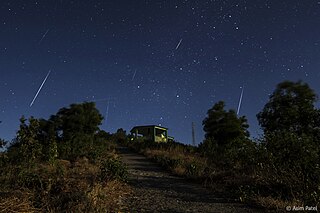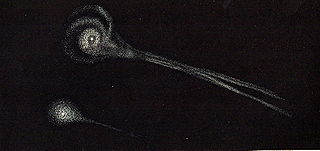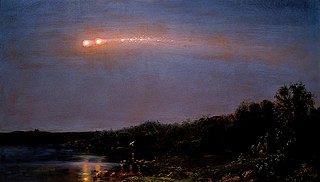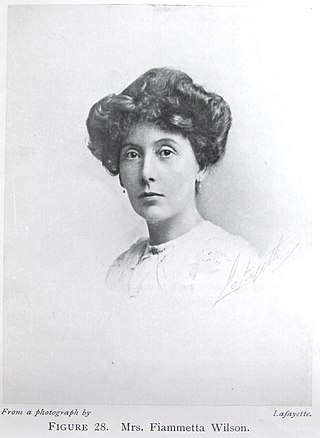Related Research Articles

The Leonids are a prolific meteor shower associated with the comet Tempel–Tuttle, which are also known for their spectacular meteor storms that occur about every 33 years. The Leonids get their name from the location of their radiant in the constellation Leo: the meteors appear to radiate from that point in the sky. Their proper Greek name should be Leontids, but the word was initially constructed as a Greek/Latin hybrid and it has been used since. The meteor shower peak should be on 17 November, but any outburst is likely to be from the 1733 meteoroid stream.

A meteoroid is a small rocky or metallic body in outer space. Meteoroids are distinguished as objects significantly smaller than asteroids, ranging in size from grains to objects up to a meter wide. Objects smaller than meteoroids are classified as micrometeoroids or space dust. Most are fragments from comets or asteroids, whereas others are collision impact debris ejected from bodies such as the Moon or Mars.

The Geminids are a prolific meteor shower caused by the object 3200 Phaethon, which is thought to be a Palladian asteroid with a "rock comet" orbit. This would make the Geminids, together with the Quadrantids, the only major meteor showers not originating from a comet. The meteors from this shower are slow moving, can be seen in December and usually peak around December 4–16, with the date of highest intensity being the morning of December 14. The shower is thought to be intensifying every year, and recent showers have seen 120–160 meteors per hour under optimal conditions, generally around 02:00 to 03:00 local time. Geminids were first observed in 1862, much more recently than other showers such as the Perseids and Leonids.

A meteor shower is a celestial event in which a number of meteors are observed to radiate, or originate, from one point in the night sky. These meteors are caused by streams of cosmic debris called meteoroids entering Earth's atmosphere at extremely high speeds on parallel trajectories. Most meteors are smaller than a grain of sand, so almost all of them disintegrate and never hit the Earth's surface. Very intense or unusual meteor showers are known as meteor outbursts and meteor storms, which produce at least 1,000 meteors an hour, most notably from the Leonids. The Meteor Data Centre lists over 900 suspected meteor showers of which about 100 are well established. Several organizations point to viewing opportunities on the Internet. NASA maintains a daily map of active meteor showers.

In astronomy, the zenithal hourly rate (ZHR) of a meteor shower is the number of meteors a single observer would see in an hour of peak activity if it was at the zenith, assuming the seeing conditions are excellent. The rate that can effectively be seen is nearly always lower and decreases the closer the radiant is to the horizon.

Biela's Comet or Comet Biela was a periodic Jupiter-family comet first recorded in 1772 by Montaigne and Messier and finally identified as periodic in 1826 by Wilhelm von Biela. It was subsequently observed to split in two and has not been seen since 1852. As a result, it is currently considered to have been destroyed, although remnants appeared to have survived for some time as a meteor shower, the Andromedids.

The Ursid (URS) meteor activity begins annually around December 17 and runs for over a week, until the 25th or 26th. This meteor shower is named for its radiant point, which is located near the star Beta Ursae Minoris (Kochab) in the constellation Ursa Minor.

The Astronomical Observatory of Modra, also known as Modra Observatory or the Astronomical and Geophysical observatory in Modra, is an astronomical observatory located in Modra, Slovakia. It is owned and operated by the Comenius University in Bratislava. The scientific research at the observatory is led by the Department of Astronomy, Physics of the Earth and Meteorology, Faculty of Mathematics, Physics and Informatics.
The eSTAR project was a multi-agent system that aimed to implement a heterogeneous network of robotic telescopes for automated observing, and ground-based follow-up to transient events. The project is a joint collaboration between the Astrophysics Group of the University of Exeter and the Astrophysics Research Institute at Liverpool John Moores University. The project was led by Alasdair Allan and Tim Naylor at the University of Exeter, and Iain Steele at Liverpool John Moores University. The eSTAR Project was affiliated with the RoboNet Consortium, and the global Heterogeneous Telescope Networks Consortium.
The October Draconids, in the past also unofficially known as the Giacobinids, are a meteor shower whose parent body is the periodic comet 21P/Giacobini-Zinner. They are named after the constellation Draco, where they seemingly come from. Almost all meteors which fall towards Earth ablate long before reaching its surface. The Draconids are best viewed after sunset in an area with a clear dark sky.
Halley's Comet, named after English astronomer Edmund Halley who first demonstrated its periodicity, returns to the vicinity of the Sun and Earth approximately every 76 years. Since comets are believed to be the most primordial objects in the solar system, their study is of great importance to planetary science. At the time of the 1986 return of the comet, astronomical telescopes and related instrumentation were vastly more sensitive than for any previous apparition. Consequently, the International Halley Watch (IHW) was organized to stimulate, standardize, collect, and archive observations of the comet.

Doyle Peak is a peak in the Coconino National Forest, and the fourth-highest peak in the San Francisco Peaks of northern Arizona. It is the sixth-highest named point in the state of Arizona, with an elevation of 11,464 feet (3,494 m).
The following are considered ocean essential climate variables (ECVs) by the Ocean Observations Panel for Climate (OOPC) that are currently feasible with current observational systems.
An atmospheric reanalysis is a meteorological and climate data assimilation project which aims to assimilate historical atmospheric observational data spanning an extended period, using a single consistent assimilation scheme throughout.

A meteor procession occurs when an Earth-grazing meteor breaks apart, and the fragments travel across the sky in the same path. According to physicist Donald Olson, only four occurrences are known:

The 1783 Great Meteor was a meteor procession observed on 18 August 1783 from the British Isles, at a time when such phenomena were not well understood. The meteor was the subject of much discussion in the Philosophical Transactions of the Royal Society and was the subject of a detailed study by Charles Blagden.

Comet ISON, formally known as C/2012 S1, was a sungrazing comet from the Oort cloud which was discovered on 21 September 2012 by Vitaly Nevsky and Artyom Novichonok.

Fiammetta Wilson was a British astronomer elected a fellow of the Royal Astronomical Society in 1916.

The NOAA Cooperative Observer Program (COOP) is a citizen weather observer network run by the U.S. National Weather Service (NWS) and National Centers for Environmental Information (NCEI). Over 8,700 volunteers from the fifty states and all territories report at least daily a variety of weather conditions such as daily maximum and minimum temperatures, 24-hour precipitation totals, including snowfall, and significant weather occurrences throughout a day that are recorded via remarks in observer logs. Some stations also report stream stage or tidal levels.